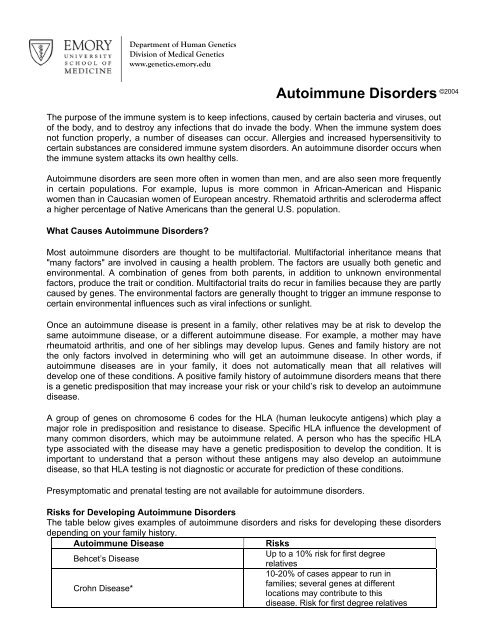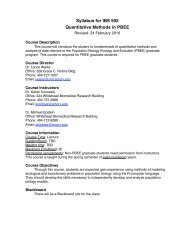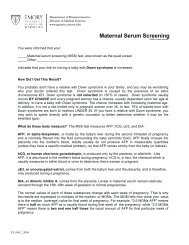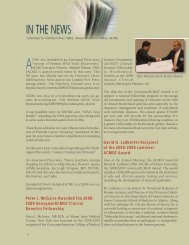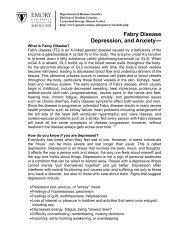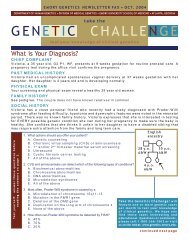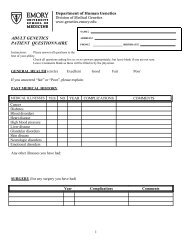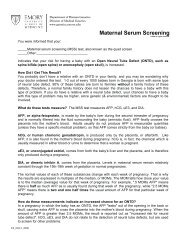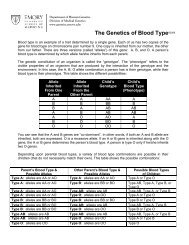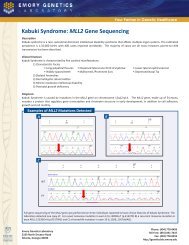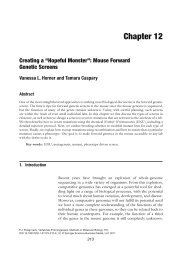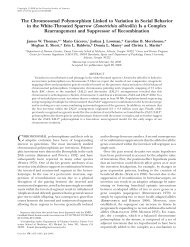Autoimmune Disorders - Emory University Department of Human ...
Autoimmune Disorders - Emory University Department of Human ...
Autoimmune Disorders - Emory University Department of Human ...
Create successful ePaper yourself
Turn your PDF publications into a flip-book with our unique Google optimized e-Paper software.
<strong>Autoimmune</strong> <strong>Disorders</strong> ©2004<br />
The purpose <strong>of</strong> the immune system is to keep infections, caused by certain bacteria and viruses, out<br />
<strong>of</strong> the body, and to destroy any infections that do invade the body. When the immune system does<br />
not function properly, a number <strong>of</strong> diseases can occur. Allergies and increased hypersensitivity to<br />
certain substances are considered immune system disorders. An autoimmune disorder occurs when<br />
the immune system attacks its own healthy cells.<br />
<strong>Autoimmune</strong> disorders are seen more <strong>of</strong>ten in women than men, and are also seen more frequently<br />
in certain populations. For example, lupus is more common in African-American and Hispanic<br />
women than in Caucasian women <strong>of</strong> European ancestry. Rhematoid arthritis and scleroderma affect<br />
a higher percentage <strong>of</strong> Native Americans than the general U.S. population.<br />
What Causes <strong>Autoimmune</strong> <strong>Disorders</strong>?<br />
Most autoimmune disorders are thought to be multifactorial. Multifactorial inheritance means that<br />
"many factors" are involved in causing a health problem. The factors are usually both genetic and<br />
environmental. A combination <strong>of</strong> genes from both parents, in addition to unknown environmental<br />
factors, produce the trait or condition. Multifactorial traits do recur in families because they are partly<br />
caused by genes. The environmental factors are generally thought to trigger an immune response to<br />
certain environmental influences such as viral infections or sunlight.<br />
Once an autoimmune disease is present in a family, other relatives may be at risk to develop the<br />
same autoimmune disease, or a different autoimmune disease. For example, a mother may have<br />
rheumatoid arthritis, and one <strong>of</strong> her siblings may develop lupus. Genes and family history are not<br />
the only factors involved in determining who will get an autoimmune disease. In other words, if<br />
autoimmune diseases are in your family, it does not automatically mean that all relatives will<br />
develop one <strong>of</strong> these conditions. A positive family history <strong>of</strong> autoimmune disorders means that there<br />
is a genetic predisposition that may increase your risk or your child’s risk to develop an autoimmune<br />
disease.<br />
A group <strong>of</strong> genes on chromosome 6 codes for the HLA (human leukocyte antigens) which play a<br />
major role in predisposition and resistance to disease. Specific HLA influence the development <strong>of</strong><br />
many common disorders, which may be autoimmune related. A person who has the specific HLA<br />
type associated with the disease may have a genetic predisposition to develop the condition. It is<br />
important to understand that a person without these antigens may also develop an autoimmune<br />
disease, so that HLA testing is not diagnostic or accurate for prediction <strong>of</strong> these conditions.<br />
Presymptomatic and prenatal testing are not available for autoimmune disorders.<br />
Risks for Developing <strong>Autoimmune</strong> <strong>Disorders</strong><br />
The table below gives examples <strong>of</strong> autoimmune disorders and risks for developing these disorders<br />
depending on your family history.<br />
<strong>Autoimmune</strong> Disease Risks<br />
Up to a 10% risk for first degree<br />
Behcet’s Disease<br />
Crohn Disease*<br />
<strong>Department</strong> <strong>of</strong> <strong>Human</strong> Genetics<br />
Division <strong>of</strong> Medical Genetics<br />
www.genetics.emory.edu<br />
relatives<br />
10-20% <strong>of</strong> cases appear to run in<br />
families; several genes at different<br />
locations may contribute to this<br />
disease. Risk for first degree relatives
depends on the study (10-40 fold<br />
increase).<br />
Autosomal dominant inheritance (50%<br />
recurrence risk) has been reported,<br />
Dermatitis herpetiformis<br />
however, females are more <strong>of</strong>ten<br />
affected than males.<br />
Clusters in families with other<br />
Grave’s Disease<br />
autoimmune disorders; recurrence<br />
risks not specified.<br />
Clusters in families with other<br />
Hashimoto’s thyroiditis<br />
autoimmune disorders; recurrence<br />
risks not specified.<br />
3-5% for first degree relatives; 38% for<br />
monozygotic twins; 30% for <strong>of</strong>fspring <strong>of</strong><br />
2 affected parents; 0.5-3% for brothers<br />
<strong>of</strong> an affected sibling; 13% for a brother<br />
to have MS if he has an affected sibling<br />
Multiple Sclerosis<br />
and one parent with MS (age <strong>of</strong> onset<br />
21-30 yrs); 1.5-8% for sisters <strong>of</strong> an<br />
affected sibling; 7-50% for a sister to<br />
have MS if she has an affected sibling<br />
and one affected parent.<br />
Genetically heterogeneous. Usually<br />
occurs by chance; 1 to 4 % <strong>of</strong> cases<br />
cluster in a family; familial<br />
predisposition may be due to<br />
Myasthenia Gravis<br />
autoimmunity in general; there is also<br />
an autosomal recessive<br />
(congenital/infantile form; 25% RR) and<br />
autosomal dominant form (50% RR).<br />
Some studies show autosomal<br />
Pemphigus vulgaris<br />
dominant inheritance with up to 50%<br />
recurrence risk.<br />
20% <strong>of</strong> relatives with pernicious<br />
anemia, have pernicious anemia,<br />
Pernicious Anemia<br />
especially first-degree female relatives;<br />
more common in Caucasians;<br />
recurrence risks not specified.<br />
Clusters in families with other<br />
Polymyositis/Dermatomyositis<br />
autoimmune disorders; recurrence<br />
risks not specified.<br />
One-third <strong>of</strong> cases appear to run in<br />
families. More commonly seen in<br />
Caucasians, and more common in<br />
women. Lifetime risk if one parent has<br />
Psoriasis<br />
psoriasis = 0.28; if both parents=0.65.<br />
If one parent and one affected child,<br />
RR=0.51; if both parents and one<br />
affected child, RR=0.83. If one affected<br />
child (parents unaffected), RR=0.24.<br />
Females are 2-3 times more likely to<br />
be affected than males; risk for parents<br />
and siblings <strong>of</strong> an affected individual is<br />
Rheumatoid Arthritis<br />
about 2-4.5%. For an affected<br />
individual to have an affected child, risk<br />
is 0.7%.<br />
Scleroderma 1% RR for first degree relatives
Sjogren syndrome<br />
Spondyloarthropathies (such as<br />
ankylosing spondylitis)<br />
Systemic lupus erythematosus (SLE)<br />
Type I or Immune Mediated Diabetes<br />
Mellitus<br />
Ulcerative Colitis*<br />
Vitiligo<br />
9/10 pts. are women; 50% <strong>of</strong> cases<br />
occur alone while 50% <strong>of</strong> cases occur<br />
in the presence <strong>of</strong> another autoimmune<br />
disease; recurrence risks not specified.<br />
For first degree relatives, general RR<br />
4% for ankylosing spondylitis; w/HLA-<br />
B27 antigen RR 9%; w/out HLA-B27<br />
antigen, RR


